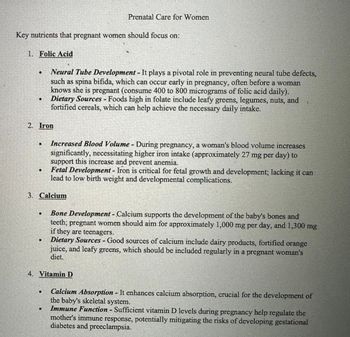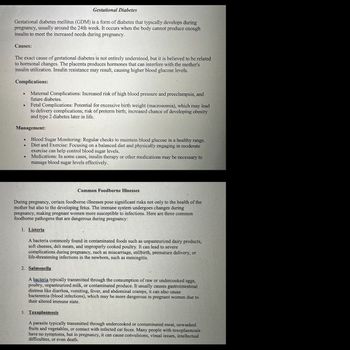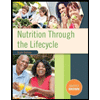
Nutrition Through The Life Cycle
7th Edition
ISBN: 9781337919333
Author: Brown, Judith E.
Publisher: Cengage Learning,
expand_more
expand_more
format_list_bulleted
Question
Please provide 3 seperate reflections: Trying adding your own thoughts to the reflections

Transcribed Image Text:Prenatal Care for Women
Key nutrients that pregnant women should focus on:
1. Folic Acid
Neural Tube Development - It plays a pivotal role in preventing neural tube defects,
such as spina bifida, which can occur early in pregnancy, often before a woman
knows she is pregnant (consume 400 to 800 micrograms of folic acid daily).
Dietary Sources - Foods high in folate include leafy greens, legumes, nuts, and
fortified cereals, which can help achieve the necessary daily intake.
2. Iron
Increased Blood Volume - During pregnancy, a woman's blood volume increases
significantly, necessitating higher iron intake (approximately 27 mg per day) to
support this increase and prevent anemia.
1
Fetal Development - Iron is critical for fetal growth and development; lacking it can
lead to low birth weight and developmental complications.
3. Calcium
Bone Development - Calcium supports the development of the baby's bones and
teeth; pregnant women should aim for approximately 1,000 mg per day, and 1,300 mg
if they are teenagers.
Dietary Sources - Good sources of calcium include dairy products, fortified orange
juice, and leafy greens, which should be included regularly in a pregnant woman's
diet.
4. Vitamin D
Calcium Absorption - It enhances calcium absorption, crucial for the development of
the baby's skeletal system.
Immune Function - Sufficient vitamin D levels during pregnancy help regulate the
mother's immune response, potentially mitigating the risks of developing gestational
diabetes and preeclampsia.

Transcribed Image Text:Gestational Diabetes
Gestational diabetes mellitus (GDM) is a form of diabetes that typically develops during
pregnancy, usually around the 24th week. It occurs when the body cannot produce enough
insulin to meet the increased needs during pregnancy.
Causes:
The exact cause of gestational diabetes is not entirely understood, but it is believed to be related
to hormonal changes. The placenta produces hormones that can interfere with the mother's
insulin utilization. Insulin resistance may result, causing higher blood glucose levels.
Complications:
•
Maternal Complications: Increased risk of high blood pressure and preeclampsia, and
future diabetes.
Fetal Complications: Potential for excessive birth weight (macrosomia), which may lead
to delivery complications; risk of preterm birth; increased chance of developing obesity
and type 2 diabetes later in life.
Management:
Blood Sugar Monitoring: Regular checks to maintain blood glucose in a healthy range.
Diet and Exercise: Focusing on a balanced diet and physically engaging in moderate
exercise can help control blood sugar levels.
Medications: In some cases, insulin therapy or other medications may be necessary to
manage blood sugar levels effectively.
Common Foodborne Illnesses
During pregnancy, certain foodborne illnesses pose significant risks not only to the health of the
mother but also to the developing fetus. The immune system undergoes changes during
pregnancy, making pregnant women more susceptible to infections. Here are three common
foodborne pathogens that are dangerous during pregnancy:
1. Listeria
A bacteria commonly found in contaminated foods such as unpasteurized dairy products,
soft cheeses, deli meats, and improperly cooked poultry. It can lead to severe
complications during pregnancy, such as miscarriage, stillbirth, premature delivery, or
life-threatening infections in the newborn, such as meningitis.
2. Salmonella
A bacteria typically transmitted through the consumption of raw or undercooked eggs,
poultry, unpasteurized milk, or contaminated produce. It usually causes gastrointestinal
distress like diarrhea, vomiting, fever, and abdominal cramps, it can also cause
bacteremia (blood infections), which may be more dangerous in pregnant women due to
their altered immune state.
3. Toxoplasmosis
A parasite typically transmitted through undercooked or contaminated meat, unwashed
fruits and vegetables, or contact with infected cat feces. Many people with toxoplasmosis
have no symptoms, but in pregnancy, it can cause convulsions, visual issues, intellectual
difficulties, or even death.
Expert Solution
This question has been solved!
Explore an expertly crafted, step-by-step solution for a thorough understanding of key concepts.
Step by stepSolved in 2 steps

Knowledge Booster
Similar questions
- Premenstrual syndrome (PMS) can include mood swings, fluid retention (edema), anxiety, backache and joint pain, food cravings, and other symptoms. PMS usually develops after ovulation and lasts until just before or just after menstruation begins. Although the precise cause of PMS is unknown, it seems clearly related to the cyclic production of ovarian hormones. After reviewing Figure 16.3, suggest which hormonal changes may trigger PMS. Figure 16.3 Animated! Hormones govern the menstrual and ovarian cycles. A GnRH from the hypothalamus stimulates the anterior pituitary to secrete FSH and LH. B FSH and LH stimulate a follicle to grow, an oocyte to mature, and the ovaries to secrete progesterone and estrogens that stimulate the endometrium to rebuild. C A midcycle LH surge triggers ovulation and the formation of a corpus luteum. D Progesterone and some estrogens released by the corpus luteum maintain the endometrium, but if no pregnancy occurs, they stop being released and the corpus luteum breaks down. ( Cengage Learning)arrow_forward________ Although the incidence of neural tube defects in the United States declined post-folic acid fortification, some women are still at risk. Which of the following options represents a risk group for inadequate folate status and a neural tube defect affected pregnancy? a. Non-Hispanic Black women b. Non-Hispanic White women c. Asian Americans d. Hispanic Americansarrow_forwardIn adults, too much __________ can cause acromegaly. a. melatonin b. cortisol c. insulin d. growth hormonearrow_forward
arrow_back_ios
arrow_forward_ios
Recommended textbooks for you
 Nutrition Through The Life CycleHealth & NutritionISBN:9781337919333Author:Brown, Judith E.Publisher:Cengage Learning,
Nutrition Through The Life CycleHealth & NutritionISBN:9781337919333Author:Brown, Judith E.Publisher:Cengage Learning, Nutrition Through the Life Cycle (MindTap Course ...Health & NutritionISBN:9781305628007Author:Judith E. BrownPublisher:Cengage Learning
Nutrition Through the Life Cycle (MindTap Course ...Health & NutritionISBN:9781305628007Author:Judith E. BrownPublisher:Cengage Learning- Essentials of Pharmacology for Health ProfessionsNursingISBN:9781305441620Author:WOODROWPublisher:Cengage
 Human Biology (MindTap Course List)BiologyISBN:9781305112100Author:Cecie Starr, Beverly McMillanPublisher:Cengage Learning
Human Biology (MindTap Course List)BiologyISBN:9781305112100Author:Cecie Starr, Beverly McMillanPublisher:Cengage Learning

Nutrition Through The Life Cycle
Health & Nutrition
ISBN:9781337919333
Author:Brown, Judith E.
Publisher:Cengage Learning,

Nutrition Through the Life Cycle (MindTap Course ...
Health & Nutrition
ISBN:9781305628007
Author:Judith E. Brown
Publisher:Cengage Learning



Essentials of Pharmacology for Health Professions
Nursing
ISBN:9781305441620
Author:WOODROW
Publisher:Cengage

Human Biology (MindTap Course List)
Biology
ISBN:9781305112100
Author:Cecie Starr, Beverly McMillan
Publisher:Cengage Learning